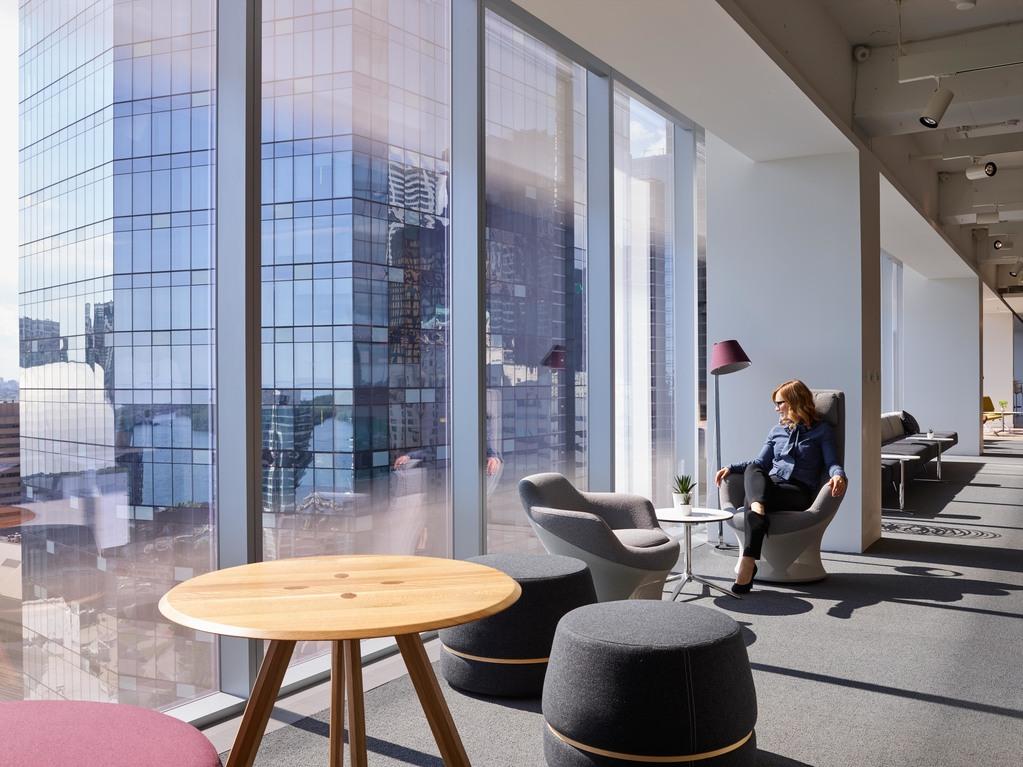Aggressive Action on CO2 Emissions Could Save Thousands of Lives in U.S. Cities


As temperatures continue to heat up across the U.S. this June, a new paper published by U.S. and U.K. scientists says that “immediate and drastic emissions cuts are key to preventing large increases in heat-related deaths in the country” by the end of the century.
Cities like Chicago, Los Angeles, Miami, New York and Philadelphia could face the highest number of fatalities linked to CO2 emissions, predicts the paper published last week in Science Advances. Its authors say older adults, children and outdoor workers could be most at risk.
The planet will warm by about 3 degrees Celsius above pre-industrial levels by the end of the century if the U.S. and other nations meet only their current commitment to the Paris Climate Agreement. But if efforts are intensified to meet the Agreement’s goal of limiting temperature rise to well below 2 degrees Celsius thousands of lives could be saved.
The paper is the first of its kind to examine the impact on mortality rates of projected high temperatures associated with extreme heat expected to occur once every 30 years on average in 15 U.S. cities. The paper was led by scientists from the University of Bristol in the U.K., the Union of Concerned Scientists, and the University of Washington’s School of Public Health.
Study says deaths linked to CO2 emissions are preventable
“All heat-related deaths are potentially preventable,” said Kristie L. Ebi, professor and researcher at the University of Washington. “We need urgent investment in heat wave early warning and response systems and other options to protect the most vulnerable as temperatures continue to rise. In the long term, urban planning must prioritize design changes that decrease urban heat islands and ensure our infrastructure is prepared for unprecedented temperatures.”
Climate change is already increasing the severity of extreme heat. If global temperatures reach 3 degrees Celsius, the cities in the study would experience more severe heat waves than if temperature-rise is limited to 1.5 or 2 degrees Celsius. At 3 degrees Celsius, there would be between about 330 and 5,800 heat-related deaths per city for each 1-in-30-year event. Limiting global temperature rise to 2 degrees Celsius avoids between about 70 and 1,980 extreme heat-related deaths per city. Even more heat related deaths—between about 110 and 2,720—can be avoided by achieving the 1.5 degrees Celsius threshold.
The paper’s authors note that the numbers of avoided heat-related deaths in the analysis may be conservative, as they relied on current population data that does not account for an aging population, increases in urbanization, exacerbation of the urban heat island effect, or other demographic factors that could change and contribute to added heat vulnerability.
“This study shows that taking urgent action to reduce carbon pollution will save lives in cities across the United States,” said Peter Frumhoff, director of science and policy and chief climate scientist at the Union of Concerned Scientists. “The government also has an obligation to help communities prepare for life in a world that’s heating up. This could include making air conditioning more available especially to those with low or fixed incomes, strengthening our health care system, and increasing awareness of heat-related health risks.”
Business joins call for government action
Many businesses have long embraced their obligations to reduce emissions. Now they are also calling on governments to do more. Late last year, 50 CEOs urged greater collaboration to accelerate outcomes in the race against climate change. An open letter published by the World Economic Forum on behalf of the Alliance of CEO Climate Leaders urged world leaders to:
- Implement effective carbon pricing mechanisms that drive a meaningful price on carbon across the globe
- Stimulate low-carbon finance and investments by offering coherent policies that shift financial flows from high-carbon investments to the low-carbon economy, thereby encouraging innovation, as well as adaptation investments
- Develop policy tools that help educate and positively influence societal demand for low-carbon solutions
“We absolutely cannot pursue a business-as-usual approach. Business and government must forge new partnerships that are able to drive results much more quickly than our current international architecture allows,” said Dominic Waughray, Head of the Centre for Global Public Goods, World Economic Forum.
With temperatures expected to continue to spike in the weeks ahead, we can only hope that world leaders are listening.
Image credit: David Mark/Pixabay
The Not-So-Hidden Messages Behind Michael Bloomberg’s New Beyond Carbon Campaign


Former New York Mayor Michael Bloomberg created a media firestorm earlier this week when he announced the launch of Beyond Carbon, a new $500 million campaign aimed at closing all the remaining coal-fired power plants in the U.S. by 2030.
From the perspective of public policy, the task appears to be an impossible one. The 2030 goal is barely more than 10 years away, and coal still provides for just over one-fourth of the nation’s electricity generation, according to the U.S. Energy Information Administration.
However, that’s just the top-down perspective.
When viewed from the bottom-up perspective of thousands of individual stakeholders in the U.S. business community, a different picture emerges.
Action steps for a low carbon future
The 2030 coal power goal has garnered the most attention from the media, but Beyond Carbon encompasses much more. It lays out a roadmap that shows how business can take concrete, meaningful actions that help put the 2030 goal within reach.
In a nutshell, that’s the hidden messages behind the Beyond Carbon campaign. The low carbon future is not some far-off dream. Technology is available today that can make it happen.
To prove it, the Beyond Carbon website provides a short list of four action steps that may already be familiar to any business with a track record in sustainability.
Shedding coal and natural gas, too
The first item is to replace both coal and gas power plants with “renewable and zero carbon energy sources.” That may be the easiest action for some businesses to accomplish, though perhaps the most difficult for some others.
Until recent years, businesses seeking wind and solar-sourced electricity had to develop their own arrays of solar panels and wind turbines. That market is still growing, but now many ratepayers can simply access wind and solar through their local utility.
Some utilities are becoming more proactive about offering wind and solar options for local businesses.
Local governments are also becoming more aggressive about negotiating with utilities for more wind and solar on behalf of ratepayers, partly through new community choice aggregation programs.
In addition, new financial tools are emerging to help smaller businesses (and nonprofits, too) gain a foothold in renewable energy.
Innovating for renewable energy
One interesting initiative to emerge in that category is a renewable energy collaboration involving Bloomberg, Cox Enterprises, Gap Inc., Salesforce and Workday. The five global companies recently joined together in an aggregation partnership aimed at kickstarting a new 42.5 megawatt solar farm in North Carolina. With these “anchor tenants” on board, the project can get off the ground and make solar-sourced electricity available to other, smaller buyers.
New blockchain software that creates seamless transactions between renewable energy owners and buyers is also coming into play.
Rounding out the picture is the emergence of market research firms that promote transparency in renewable energy pricing.
To top it all off, the Department of Energy continues to be a powerful advocate for wind and solar.
Among many Energy Department initiatives is the SolSmart program, which aims at streamlining local regulations for solar installations. The agency is also working with the nation’s tribal governments and the vast rural electric cooperative network to introduce more renewable energy in local communities.
The renewable energy transition, one vehicle (and building) at a time
Two other items on the Beyond Carbon list are well within the grasp of many U.S. businesses: replacing petroleum-fueled vehicles with electric vehicles, and replacing oil and gas in building systems with electricity.
While vehicle emissions seem to be engaging more public attention, emissions from buildings are also a significant source of greenhouse gas emissions in the U.S.
That explains why building electrification is suddenly becoming a hot topic. Electrification also provides a good bottom line justification to invest in electric heat pumps and other energy efficiency upgrades.
The low carbon industrial revolution of the future
The fourth action step involves modernizing industry and infrastructure to reduce emissions.
Beyond Carbon specifically calls for ending “wasteful flaring and leakage of methane gas.”
That seems to be targeting livestock and agriculture operations, but businesses in other sectors can also contribute by encouraging the use of lower-emission systems in their supply chain.
The methane gas issue also involves the production and use of petrochemicals based on oil and coal as well as natural gas.
Here, too, businesses can be alert for opportunities to reduce carbon in their supply chains. Cutting down on single-use plastics is one good example. Another is sourcing hydrogen from renewable resources rather than fossil natural gas.
What about nuclear energy?
Businesses that are sensitive to opponents of nuclear energy should also be aware that the Beyond Carbon campaign leaves the door open for additional nuclear development. While focusing strongly on renewables, the campaign specifically includes “zero carbon” electricity sources alongside renewables.
The prospects for growth in the U.S. nuclear power generation sector may seem remote, considering recent debacles like the cost overruns at the Vogtle nuclear power plant.
However, nuclear stakeholders continue to hold out for a brighter future in their industry. The Beyond Carbon campaign dovetails with that aim by calling for the mass electrification of buildings and vehicles.
Gains in energy efficiency can help offset some of the increased demand for electricity, but nuclear advocates argue that renewable energy is insufficient to achieve aggressive zero-carbon goals.
Regardless of the role (or not) of nuclear energy, businesses that seek to help build the low carbon economy of the future have many opportunities to do that right now, both through direct action and by steering their supply chains in a more sustainable direction.
Image credit: Diana Parkhouse/Unsplash
Brand Reputation at Stake: How Bayer Creates a New Headache for Sandals


Over the past year, leading companies have been taking steps to preserve their brand reputation by withdrawing support from two shows on Fox News, Tucker Carlson Tonight and Laura Ingraham’s The Ingraham Angle. Those decisions can have an impact on companies that remain as advertisers on those shows.
One recent example is Sandals Resorts International. The company fell into the media spotlight last week as one of the few remaining high-profile brands to continue advertising on the two Fox programs, after reports surfaced that Bayer AG has stopped advertising during those slots.
When boycotts work: toxic speech drives leading advertisers away
The Bayer decision came to light last week, when independent journalist Judd Legum reported that Bayer had stopped advertising on the two prime-time Fox News shows.
Bayer dropped Fox from its advertising roster last year only to return several months later, but this time the break could be permanent.
Since last year, toxic comments by Carlson and Ingraham have driven away a growing number of companies concerned about brand reputation.
At The Ingraham Angle, ratings are up but advertising time has plummeted. Hulu, Johnson & Johnson, Liberty Mutual, Wayfair and now Bayer are among the major that have dropped ties over the last year. Though Bayer and some of the others eventually drifted back, the company’s new stance on Fox advertising could motivate other high profile brands to rethink their relationship on a more permanent basis.
Carlson is also experiencing the boycott effect. Earlier this year The Los Angeles Times took stock of Carlson's Fox show:
“…Many blue chip companies such as Lexus, Jaguar, Pacific Life and Pfizer, have pulled out of Carlson’s program, which now relies heavily on commercials from advertisers with 1-800 numbers who tend to seek out lower-priced ad time.”
The Times also noted that “the boycotts pose a threat to further revenue growth over the long term,” citing a 45 percent year-over-year decline in fourth quarter advertising revenue from.
Brand reputation at stake
Bayer’s departure from the Carlson and Ingraham shows puts more pressure on the remaining high profile advertisers.
As the most frequent advertiser remaining on Ingraham Angle, Sandals is especially vulnerable to criticism, and the Bayer decision comes at an awkward time for the company.
Just a few months ago, on March 18, Sandals celebrated the 10-year anniversary of the Sandals Foundation by committing to 10 more years of investing in community projects throughout the Caribbean.
The company itself has also recently embarked on several noteworthy corporate social responsibility (CSR) initiatives, including a partnership with the nonprofit organization Oceanic Global to remove single-use plastics from its operations. The ongoing effort started last year with straws, stirrers, laundry bags and gift shop bags. Sandals anticipates eliminating other plastics by a self-imposed deadline of September this year.
Sandals also participates in the EarthCheck environmental benchmarking and certification program. The new 10-year commitment lays out an ambitious agenda for environmental action, with a strong emphasis on local employment and education as well as volunteer opportunities for guests.
Sandals has also made progress on social issues. In 2004 the company modified its “couples only” policy to create a more inclusive environment for LGBTQ guests. In 2017 the revised “adult couples only” policy received widespread attention when country music star Cody Alan proposed to his partner at a Sandals resort in Jamaica.
As Sandals doubles down on its CSR commitments, it will be interesting to see how the company responds to any further incidents of toxic speech at Fox News.
Image credit: John Iglar/Pixabay; Gage Skidmore/Wiki Commons
Lab Created Fish: Innovation That Could Help Save Our Oceans


Imagine you go out to eat and you order the salmon filet. The fish is tender, with a pan-seared crispy exterior, packed with umami and a hint of lemon. To your surprise, you may find out that this salmon, thanks to BlueNalu, was grown in a lab.
BlueNalu, a California-based company, is working to make lab-grown fish, or “cellular aquaculture,” a possibility. Challenges currently sidetracking the global seafood industry, such as overfishing, illegal fishing, rising ocean temperatures and contaminated fish, make it absolutely necessary to find ways to make seafood more sustainable - so alternatives to fish, such as what BlueNalu offers, could be next up on the menu.
Lab created fish to the rescue?
BlueNalu’s employees collect cells and tissue from a live fish and then grown them in a laboratory. The end result is similar to a naturally-caught fish, in that this product shares the same type of cells and tissues, but it does not have bones or scales.
When announcing the company’s launch in 2018, Lou Cooperhouse, BlueNalu’s CEO said, “BlueNalu will disrupt and supplement the current industry practice, in which fish are farmed or wild-caught in our oceans and seas. Instead, we will produce real seafood products directly from fish cells, that are as delicious and nutritious as products that have been grown conventionally, in a way that is healthy for people, humane for animals, and sustainable for our planet.”
According to this industry’s supporters, lab-created fish, once it becomes cost-competitive, would not have toxins like mercury, microplastics, parasites or bacteria that can be found in wild-caught or farm-raised fish. Hence there’s an opportunity to appeal to consumers who avoid “natural” fish due to fear about these contaminants. Furthermore, by cultivating this alternative to fish near cities and other populated areas, there would also be both reduced transportation costs and emissions.
Less waste, cost and energy
Lab-created fish could also reduce waste by growing only the “valuable” part of the meat, therefore eliminating waste. According to Phys.org, fish cells can grow at room temperature, unlike animal cells – which could reduce temperature-related costs such as air conditioning and freezing, thus making the product more financially and environmentally-friendly. A pescatarian diet could also have less of an environmental impact than other meats since fish do not require as much space, food, or other costs as, say, beef does.
However, there may be consumer pushback against lab-grown fish, due to unfamiliarity and a constant comparison to naturally-caught fish. The company states it uses real fish cells, with no genetic modification or change. Again, the cells are likened to that of live fish, except grown outside of the body of one.
“We are not any more 'lab-made' than ketchup or Oreos,” commented Chris Dammann, BlueNalu's chief technology officer. “They're all started in a lab.”
One challenge facing the company is ensuring the taste of the lab-created fish meets consumer expectations, so that people will be unable to differentiate between, and ideally prefer, lab-created meat over conventionally-caught fish.
In addition to meeting these consumer expectations and doubts, there are still scientific and financial roadblocks: determining how to mass produce enough lab-created fish to meet demand and how to lower the cost of these alternatives to conventionally-sourced fish. The price must be affordable for consumers and restaurants as well. The company, in an April press release, announced it would develop products from finfish, crustaceans and mollusks that currently are overfished, often imported into the U.S., and have been proven to be difficult to raise in aquaculture facilities.
Impossible Foods and Beyond Meat have opened the door
There is still much research and development to be done before this product will hit the markets, but if it the recent track record of meat alternative companies shows any indication, this nascent sector could experience future success. Just take a look at Impossible Foods, which has found success at chains such as Burger King. Another alternative meat company, Beyond Meat, is also disrupting the fast food industry, and scored plenty of buzz with its recent IPO.
So whether we’re talking about a quick meal of Beyond Meat Tacos at Del Taco, or a splurge on the Impossible Foods burger at Momofuku, we should see more protein options due to the efforts of companies like BlueNalu.
Could a lab-grown Filet-O-Fish be coming soon?
Image credit: Giovanna Gomes/Unsplash
In Vegas, The Venetian Bets on Seafood Sustainability for World Oceans Day


The global celebration World Oceans Day celebrates oceans every June 8 in an effort to raise awareness of their importance - from providing food to moderating our climate to even providing important medicines. In honor of this day, FishWise and The Venetian Resort Las Vegas have joined forces to monitor seafood sustainability at this popular hotel and convention center. Such a partnership is important when it comes to spreading the word at a massive scale: The Venetian hosts approximately 25 of the world’s 200 largest conventions in its meeting and exhibition spaces.
The Venetian opens new opportunities for FishWise
FishWise, which partners with the seafood industry across the value chain to achieve responsible seafood commitments, has worked with retail giants as Albertsons Companies and Target. The staff of FishWise includes marine scientists, social scientists and data analysts. Its projects have a global reach. For example, In October 2017, USAID selected FishWise to develop and implement a new global Seafood Alliance for Legality and Traceability.
The Venetian-FishWise program seeks to develop a comprehensive sustainable seafood strategy for the resort’s food service operations, which serves nearly five million meals every year. Currently, U.S. fisheries must follow 10 national standards of sustainability enforced by the National Oceanic and Atmospheric Administration’s fisheries program.
FishWise will help collect data and conduct baseline environmental, traceability, and social risk assessments of the resort’s seafood purchases. With this information, The Venetian will then develop a responsible seafood policy and procurement strategy. During implementation of the strategy, traceability, staff training, strategic communications, and outreach on partnerships will be key components.
Another step forward in sustainability for Las Vegas Sands
The Venetian’s work on seafood sustainability falls in line with its parent company’s (Las Vegas Sands Corp.) ECO360 Global Sustainability Strategy, which focuses on four key areas:
- Sustainable buildings
- More responsible and sustainable meetings and events
- Stakeholder engagement
- Environmentally responsible operations
The Venetian, along with Las Vegas Sands’ other properties, have seen progress in other areas across its sustainability agenda. The company is close to reaching its science-based 2020 target of a 6 percent reduction in greenhouse gas emissions from its 2015 baseline. Since the ECO360 program was established in 2010, the Las Vegas properties have reduced their total electricity consumption by almost 25 percent.
In addition, The Venetian recently entered into a partnership with NV Energy to offset 100 percent of its annual electricity consumption through the purchase of Renewable Energy Certificates (RECs). The resort has invested in many other eco-friendly operations.
In the convention center, Olivier Dubreuil, The Venetian’s vice president of culinary operations, considers sustainability in every decision. In 2017, he and his team introduced Honest Food, which addresses the following areas:
- Flexible and diverse menu options
- Local sourcing in a 450-mile radius
- Fresh and sustainable ingredients
- Waste reduction
Guests are becoming more interested in where their food comes from and what it contains, according to Dubreuil. He believes the FishWise partnership will help reach his goal of serving fresh and sustainable ingredients to convention guests.
The hospitality still has much work ahead on sustainable seafood
Overall, the hospitality industry is lagging behind other sectors when it comes to seafood sustainability, says Tobias Aguirre, Chief Executive Officer at FishWise. The industry is making some progress: in 2017, the Seafood Watch program, established in 1999 by the Monterey Bay Aquarium, held an industry roundtable to address this problem.
This effort has also been helped by companies including the tech firm Eachmile, which has helped boost seafood sustainability with its development a database. The Singapore-based firm has also partnered with some of the largest hotel chains (including Hyatt and Hilton) to help them understand the sustainability of a particular seafood item. Hyatt recently partnered with the World Wildlife Fund to include seafood sustainability in its 2020 Environmental Sustainability Vision. Other hotels with established programs include Fairmont Hotels and Resorts, Marriott and IHG.
The Venetian can now be added to this list and is providing a solid example for other hotel and resorts across the hospitality industry to follow. However, more hotels must become involved to address the overfishing crisis. According to the NRDC, one third of global fish populations are overexploited or close to depletion. If the hospitality industry and other sectors don’t embrace seafood sustainability on a wider scale, there soon commemorating World Oceans Day will become more of a challenge – as there will be little to celebrate if the oceans continue to be depleted.
Image credits: The Venetian
Circular Solutions: HP's New Display Is Made With Plastic Bottles From Haiti


Global manufacturers and consumers now create around 300 million tons of plastic waste annually, roughly the weight of the entire human population, according to U.N. Environment. Every year, more than 8 million tons of it ends up in our oceans, which—at this rate—will contain more plastic than fish by 2050. As concern over plastic pollution grows, stakeholders are calling on companies to embrace a circular economy—in which materials are infinitely reused and nothing becomes waste.
In this area, multinational technology company HP has been quietly working on solutions with one of its best known products, ink cartridges—and now it's moving on to more products that utilize circular technologies. This week, the company unveiled the HP Elite Display, which it bills as the world's first display monitor made with "ocean-bound plastic."
The new display contains plastic sourced from refuse collectors in Haiti, who earn a living by removing waste from ecosystems and waterways before it can reach the ocean. We spoke with Ellen Jackowski, global head of sustainability strategy and innovation for HP, to learn more.
Ink cartridges and the social side of plastic pollution
For more than 15 years, HP has collected empty ink cartridges for free at retail locations such as Staples, Best Buy and Office Depot. Its team invented a disassembly machine to take the cartridges apart and separate plastic and metal components for recycling. The plastic pieces are fortified with material from recycled plastic bottles to increase strength, before they're turned into new ink cartridges and sold back into the marketplace.
HP now recycles 1 million plastic bottles every day through this process, Jackowski told us at the Sustainable Brands conference in Detroit this week. "The volume is significant," she said. "And with that volume, there was an opportunity to do more."
The company connected with Thread International, a certified B Corporation that works with self-employed refuse collectors in Haiti to source plastic for new products. This model addresses not only the environmental impact of plastic waste, but also the social component—which is often less discussed.
Think of it this way: Western countries have successfully exported our make, take and dispose culture of single-use packaging to developing nations. But we’ve done little to ensure these countries have the waste management infrastructure necessary to deal with it. Without municipal garbage pickup, single-use plastic packaging ends up as litter. Winds and rains carry it into waterways and, eventually, to the ocean.
In Detroit, Jackowski showed us photos from her recent trip to Haiti, which depict canals choked with plastic packaging—making it painfully clear how our single-use culture impacts quality of life in countries already battling the effects of poverty. "We thought about shifting some of our supply chain," she told us. "Instead of buying that 1 million bottles a day from the North American plastics market, what if we bought some of it from Haiti?"

Circularity in Haiti: Building circular models at scale
Notably, HP worked with Thread to address a specific pain point: Several popular Haitian beverages are packaged in opaque, dark-colored bottles. The resulting material has low value in the recycling market, but for the black plastic casing on HP's ink cartridges, it works as well as anything else. By purchasing this type of plastic, HP helps to increase its value—meaning collectors and recyclers can earn more for it.
Since announcing the partnership in September 2016, HP has created nearly 800 income opportunities for Haitian refuse collectors, who are paid a living wage. It's also sourced around 25 million plastic bottles and transformed them into new ink cartridges. "In some respects, this number is insignificant when you consider 8 million metric tons of plastic flowing into the ocean every year," Jackowski said. "But for a company to set up a sustainable supply chain process and stay with it month after month, it’s a pretty huge number."
To continue to scale its work in Haiti, the company invested $2 million in a washing line that will allow its partner recycling center to accept more plastic—and employ more people. "We're estimating over 1,000 new income opportunities with this washing line," Jackowski said. The company also holds regular meetings with Haitian collectors and invests in education and other resources through a local nonprofit called Work.
"For us to extend our $50 billion supply chain and put this type of effort in at the very first mile, it's a whole new way for our supply chain to function," Jackowski told us. "This is disruptive. This is doing business differently."

New products bring new opportunities
The new Elite Display represents the next phase of HP's work in the circular economy, graduating from a somewhat mundane product like an ink cartridge to a flashy piece of technology with the potential to draw consumer interest.
More than 10 parts in the new monitor contain ocean-bound plastic, including the back panel, plastic display and web camera, equating to about three bottles per display. "This is a huge innovation," Jackowski told us. "We figured it out—how to remove the contaminants, how to maintain the same performance quality so there's no tradeoff in using this type of plastic, and how to do it while thinking about the connection between ocean plastic pollution and poverty."
The company is sharing what it learned by joining NextWave Plastics, a partnership launched in 2018 by the Lonely Whale Foundation to establish global supply chains for ocean plastic. "We've learned things that we want to share," Jackowski said. "We're working with groups like NextWave to be able to leverage that knowledge and open-source it so other companies can replicate it."
In the coming years, HP intends to keep scaling its use of ocean-bound plastic from Haiti, with the ultimate goal of creating similar collection models elsewhere around the world. "This process is going to last for the long-term," Jackowski concluded. "It isn't something that is one proof point, where we did one product and it was a great example and it made a great story. This is a strategy for how we're innovating for the future. It started with our ink cartridges, moved now to our personal systems products, and there will be more to come."
Images courtesy of HP and Thread International
Spotify Amps Volume to Get More Women in Music Production


The popular audio streaming platform Spotify recently announced it is boosting efforts to recruit more women seeking careers within the technical side of the music business.
This announcement comes at a time when the fact remains that, as with many other technical and engineering fields, music production has few women. According to a 2019 USC Annenberg Inclusion Initiative report, women comprise only 2 percent of music industry producers. The report cited other alarming statistics:
- The ratio of male to female producers across 400 popular songs is 47 to 1
- Only four out of 871 producers were women of color
- Only one in eight songwriters are women
Only six women have ever been nominated for the Producer of the Year Grammy. Similarly low numbers are found in live sound and live event production.
Why the low numbers? Women producers face many of the same challenges as women in other male-dominated technical fields: the lack of role models or mentors, sexism, and lack of recognition. Fortunately, more music companies are implementing programs to deal with some of these issues, including Spotify.
Spotify residencies could open the doors for more women
In 2018, Spotify’s Social Impact Team partnered with Berklee College of Music (Boston) to form the EQL Studio Residency. Three full-time, paid residencies were offered to women and gender non-conforming individuals from across the world. Darla Hanley, the first female academic dean at Berklee College of Music, led the program. The Berklee Women Chairs Forum group, which represents many areas of the music industry, provided mentors.
“We know that hands-on experience, access to established networks and mentorship are critical to more women succeeding in audio,” says Kerry Steib, Spotify’s director of social impact. “We recognized that by activating Spotify’s network of Secret Genius studios and partnering with Berklee College of Music, we could create a residency program that would provide those kinds of opportunities.”
During their paid six-month residencies, one participant in each of three cities (London, Nashville and New York) worked in studios and gained access to such opportunities. The EQL Residents were also full contributors to the day-to-day running of Spotify’s Secret Genius studios. They set up sessions and worked directly with artists.
“We need to continue to staff these spaces,” Steib says. “Now, we’re thinking about how to do so in an intentional way that can support equity in the industry.”
Music residencies offer both support and and an outlet for creativity
But what’s most important to Steib is that EQL Residents stay in the field and continue to work. In addition to their experience and contacts, they found value in a supported, creative environment where they gained confidence in their own talents.
In celebration of Women’s History Month, the EQL residency final project had all three residents work with the recording artist and record producer Ivy Queen to reimagine her anthem Quiero Bailar. “Working with Ivy Queen at the iconic Electric Lady Studios was an amazing way to cap off the program, to bring the residents together and to make sure the world saw the level of work they could do,” Steib points out.
The 2019 residency begins in September and also offers paid, six-month residencies in three cities: Los Angeles, Nashville and London. Feedback from the first class of EQL Residents was incorporated to improve the program. Steib says that Spotify is continuing to invest in the mentorship side with women leaders from Berklee College of Music because such mentorship was critical to the success of the first year. Spotify is also evaluating how to incorporate personal projects and interests into the work.
In addition, the company partnered with SoundGirls, a nonprofit with the goal of expanding opportunities for girls and women in music, to establish the EQL Directory. SoundGirls was founded by Karrie Keyes (the live-sound engineer for Pearl Jam) and Michelle Sabolchick Pettinato (house engineer for recording artists including Gwen Stefani, Goo Goo Dolls, Kesha and Jewel). SoundGirls initiatives include scholarships and music camps for women.
A surge in numbers for women working in all functions with the music industry
The EQL Directory is a global database of professionals working behind the scenes in music and audio. Any person can add his or her name and resume for free. After launch, The EQL Directory was able to double the number of professionals listed to approximately 1,500, and it continues to grow.
“The EQL Directory is really a community space for the women working in audio—and the industry looking to create a more inclusive creative team,” Steib says. “We work with others like Women’s Audio Mission, Gender Amplified, Yorkshire Sound Women Network, the Upfront Producer Network and Instituto Criar to ensure that whatever Spotify is developing and supporting, we’re doing so in conjunction with the organizations who are on the ground.
“We know that the only way to drive change industry wide is to work together with other companies and organizations who believe in the power of providing women with more paid, hands-on opportunities in audio,” Steib continues. “We’re starting to think about how we can help other companies host their own EQL Residents and look forward to the progress we can make as an industry.”
Spotify’s efforts are aligned with like-minded initiatives across the music sector. The Recording Academy's Task Force on Diversity and Inclusion recently launched the Producer and Engineer Inclusion Initiative, which requests musicians, record labels, and others to consider at least two female producers or engineers when working on a project. More than 200 have already pledged their commitment, including superstars like Lady Gaga, Justin Bieber and Pearl Jam.
With Spotify’s efforts and others, we can look forward to future Grammy Award ceremonies showing more diversity across the technical categories.
Image credit: Andrzej Rembowski/Pixabay
People, Planet, Prosper: Achieving a World Where People and Planet Can Prosper Together


Joseph Stiglitz, the renowned Nobel laureate economist, had a column in the New York Times recently titled, “Progressive Capitalism is Not an Oxymoron,” summing up his new book, “People, Power and Profits: Progressive Capitalism for an Age of Discontent.”
The whole premise sounded vaguely familiar somehow, and I realized that several years ago, I too had written book about a similar subject: “Greenthink: How Profit can Save the Planet.” My book, of course, was focused on a thinner slice of life – the environmental movement – but the underlying principle continues to ring true.
As Stiglitz said: “Progressive capitalism is a new social contract between voters and elected officials, between workers and corporations, between rich and poor, and between those with jobs and those who are un- or underemployed.”
I’ll go him one further – we also need a new contract between people and the planet, and a rebalancing of the relationship between business, government and environmentalists. Without it, we will surely fail.
It’s painfully clear to me that we’re in the midst of a global environmental depression. Tragically, few people understand this, because they’re trapped in a half-century-old worldview in which the private sector and the environmental community are independent actors in a zero-sum game. This antiquated, adversarial outlook isn’t just dumb; it’s devastating—to the economy and the environment. It’s also devastating to people, because climate change is a huge public health issue.
Think about it this way: Because the environmental movement still considers business its sworn enemy instead of its natural partner, it has utterly failed at the decisive moment of the most important environmental battle in history. There’s a better chance that you’ll get struck by lightning while reading this book than that Congress will pass a carbon tax in my lifetime. Global climate conventions and negotiations have unraveled so many times, I’ve lost count. Why? Because generally speaking, environmentalists continue to antagonize industry instead of partner with it. As a result, business interests end up standing in the way of agreements that could prevent catastrophic climate change. And hurting millions of people in the process.
Meanwhile, the private sector is leaving trillions on the table—not to mention condemning our planet to a terrifying future—by failing to widely embrace the extraordinary power of sustainability to drive economic growth. There are two key ways all businesses stand to gain from being environmentally conscious. First, by eliminating waste and doing things more efficiently, companies save money. Second, by using sustainability to drive innovation, new products become more effective, more desirable to customers, and thus more profitable.
The bottom line is that the tired, old narrative through which most people understand the world, and the groupthink within business, government and environmental circles that sustains it, are preventing a lot of money from being made and a lot of planet from being saved. But a new narrative is emerging—a new way of thinking, even—that is deeply rooted in reality, not distorted by history.
While the old narrative claims that the environment is the enemy of growth, the new narrative holds that the environment and the economy are deeply, fundamentally connected. They share common enemies: waste, inefficiency, pollution, climate change, resource scarcity, and environmental degradation. They also share a common ally: sustainability. And instead of intractable, insulated groupthink, they share a common outlook: greenthink.
Greenthink occurs when businesses, nonprofits, governments, and individuals marry environmental and economic principles for the benefits they can receive from both. Throughout the global economy, a select number of enlightened companies are already engaged in greenthink by leveraging the power of sustainability to drive profits. These businesses aren’t using less energy and fewer resources in the name of self-denial or out of the goodness of their hearts; they’re consuming less in order to earn more. The economic incentives are changing, and so are the business models. The result is a measurable reduction in the damage that many companies inflict on the environment and people, an increase in innovation and the overall quality of their products and services, and a reward in the form that business understands best: cold, hard cash. In fact, preeminent management consulting firm McKinsey & Company says that “the choice for companies today is not if, but how they should manage their sustainability activities.”
The future of the planet is at stake, and so is the future of the global economy. Environmental degradation and climate change are beginning to take an enormous economic toll that will grow by orders of magnitude in the coming years. Meanwhile, environmentally friendly business practices are creating an economic windfall for those smart enough to embrace them.
This is the new reality—and our historic opportunity. These strategies can bring us together and help us dramatically reduce our carbon footprint, eliminate harmful pollution, and build a better, greener, healthier world. We just need to be mindful that thoughtful regulation plays a role as well, providing a mechanism to make sure market power works for all of us.
Conventional wisdom tells us that sustainability is prohibitively expensive; that industry is, by definition, destructive; and that environmentalism and capitalism are diametrically opposed. But it’s time to toss that old way of thinking out a triple-glazed, energy-efficient window. Because even though the private sector and the environmental movement have long thought of themselves as adversaries—or, at best, as folks who just walk a different path—the truth is, if we don’t get our act together, we will share the same fate.
Previously posted in the 3BL Media newsroom.
Image credit: IWBI/Facebook
Why Sustainability Makes Business Sense


This article series is sponsored by Philip Morris International.
For a company like Philip Morris International to have a conversation about sustainability may seem almost inappropriate to some people. How can a tobacco company—which sells products that are harmful to the health of its consumers—talk in a credible way about sustainability?
It’s a fair question.
Sustainability needs to start with taking a hard look at the impact a company’s products have on consumers and society, and it’s no secret that cigarettes are harmful. The answer is obvious: If PMI wants to have the greatest positive impact, we have to evolve our business model.
So that’s what we have been doing since 2016, transforming our business from cigarettes to smoke-free alternatives.
Deciding to phase out the product that PMI was built on—while delivering on expectations of our employees, shareholders and the 150 million consumers of our brands—is a drastic move. Addressing the health effects of our product is a pivotal contribution to sustainability. While our sustainability efforts contribute to several United Nations Sustainable Development Goals, we have identified SDG Goal No. 3, which is to ensure healthy lives and promote well-being, as the goal for which PMI can have the greatest positive influence as we transform our business toward a smoke-free future.
“Unsmoking” the world
The best way to avoid the harm of smoking, obviously, is for smokers to quit and for others to never pick up their first cigarette. But with 1.1 billion people around the globe who do smoke, it was key for PMI to come up with better alternatives than continuing to smoke.
While nicotine is addictive and not without risk, experts agree that the primary cause of smoking-related diseases is the smoke generated by burning tobacco. Through more than a decade of extensive research—by over 400 scientists, engineers and technicians at our two research facilities—we have been developing smoke-free products that are less harmful than cigarettes.
Our goal is to switch every smoker who would otherwise keep using cigarettes to smoke-free products, and we continue to shift company resources toward achieving that ambition. Last year, smoke-free products made up roughly 5 percent of our shipments, but generated nearly 14 percent of our revenue. Moreover, already 60 percent of our global commercial expenditure and 92 percent of our investment in research and development were dedicated to smoke-free products.
And we’re on our way toward meeting our goal: Since the debut of our main smoke-free product, IQOS, in 2014, more than 7.3 million people have stopped smoking our cigarettes and switched to PMI’s heated tobacco products. It is our ambition that by 2025, at least 40 million PMI cigarette smokers will have switched to smoke-free products. Achieving this would accelerate the decline of smoking among our consumers more than three times faster compared to targets set by the World Health Organization (WHO).
Taking action
PMI is the only tobacco company to focus its efforts on replacing cigarettes with better alternatives as quickly as possible, but our sustainability ambition reaches far beyond changing our product. It extends to the way we operate and address our social and environmental sustainability challenges. And as we are making progress on our transformation journey, we are applying our sustainability approach to areas that are new to our business, such as electronics.
This includes, for instance, improving labor practices in our electronics supply chain and developing circular economy schemes to recycle our smoke-free devices. As smoke-free products require less tobacco, we are also helping farmers diversify their crops and reduce their dependence on revenues from tobacco growing.
Managing PMI’s social impact within our operations and beyond is a key pillar of our sustainability strategy. We took our Agricultural Labor Practices program, already considered industry-leading, to the next level in 2018 with a step-change approach, with the ambition to have zero child labor within our tobacco supply chain by 2025. We reinforced our human rights due diligence work and also increased the worldwide representation of women in management roles.
We are also committed to reducing our environmental footprint throughout our value chain. We are improving water stewardship and greening the energy consumption in our operations and are focusing on most relevant areas of our environmental footprint outside of our factories. This includes addressing greenhouse gas emissions, deforestation, and biodiversity in tobacco growing and curing, as well as tackling consumer waste and littering. We support the Paris Climate Agreement and have set ambitious science-based targets to reduce our carbon emissions. For the fifth year in a row, PMI achieved CDP’s Climate A-list for its comprehensive action to reduce greenhouse gas emissions and mitigate climate change and for transparency in its reporting practices.
Our efforts and the progress we are making toward the transformation, environment and social targets we have set are outlined in our newly released 2018 Sustainability Report, the fourth such document PMI has produced.
Our ambition is to become a sustainability leader, within the tobacco industry and beyond, and the core of our sustainability strategy is to unsmoke the world—as soon as possible and as sustainably as possible.
Image credit: Steven Wright via Unsplash
Young People Reward Brands That Take Stands: Here's How To Get Noticed


TriplePundit tracks the rising trend of corporate, executive and employee activism through our weekly Brands Taking Stands Newsletter and frequent coverage here on the site. And we’ve certainly found no shortage of material.
Over the past two years, outdoor labels like Patagonia and REI have sued the federal government to protect public lands. Retailers including Dick’s Sporting Goods and Walmart changed their policies on gun sales in the wake of a horrific school shooting. And Nike featured quarterback Colin Kaepernick as the face of its iconic “Just Do It” campaign, even as the National Football League effectively boycotted the former star after his public protests against police brutality and racial injustice.
Campaigns like these are resonating with consumers—particularly young people. But it takes more than a one-time stance to get noticed by the public, according to recent research from DoSomething Strategic, the social impact consulting arm of DoSomething.org, a nonprofit focused on youth engagement.
More than 65 percent of young consumers say their impression of a brand improves if the company is associated with a social cause, according to DoSomething’s survey. Yet only 12 percent of respondents had "top of mind" associations between brands and the social causes they support.
Put another way: Even though an increasing number of companies are taking public stands on social issues, it takes consistent engagement—often over several years—to get noticed by young people.
"It’s still so new," Meredith Ferguson, managing director of DoSomething Strategic, said of the Brands Taking Stands movement. "Brands that have been doing it for a while are the ones that are getting the most credit."
Dove, for example, has focused on self esteem and body confidence since 2004, "and that showed in the report," Ferguson said. More than 60 percent of those surveyed associated Dove with a social cause, with the majority naming body confidence as a top-of-mind issue for the company. Given DoSomething's findings about how young people respond to brands that take stands, it comes as no surprise that Dove's sales nearly doubled—from $2.5 billion to $4 billion—in the 10 years following the launch of its body positivity campaign.
Similarly, other brands that received top marks from young people for their social stance included Nike, with its support of Kaepernick and racial justice, and Patagonia—which has made land preservation and conservation a brand focus since its inception.
"That’s a piece of the puzzle that organizations really need to put together, which is to make sure you're saying it loud and proud, consistently," Ferguson told us at this week's Sustainable Brands conference in Detroit. "We talk a lot about the difference between educating your consumer and boasting. Consistently talking about what you stand for is very different from constantly bragging about how great you are because you stand for something. It’s a nuanced distinction that matters."
As one might expect, brands founded on purpose were also among the most recognized for their social stance—think: Bombas Socks and its mission to give back to homeless Americans with every purchase and Lush Beauty and its focus on sustainable packaging and clean ingredients. The most recognizable brands on the list are Rhianna’s beauty brand Fenty Beauty and her lingerie collection, Savage X Fenty, which launched around the causes of racial equity, body positivity and inclusion—and continue to be recognized for these issues today.
Although brands that are inherently purpose-driven may be more likely to attract attention, that's no reason for legacy companies to avoid jumping into the fray, Ferguson said.
"[Purpose-driven] brands will pop up more and more," she told us. "But I think it's easy for legacy companies to point to those brands and say, ‘Well, they get to start anew that way. It's harder for us.’ Sure, it's harder, but it’s not impossible. Don't use that as an excuse. Use it as inspiration."
Ferguson is well aware that it may be intimidating for legacy companies to go beyond marketing their products and services and take a stand on a social cause. But as we've covered here on 3p, staying silent is just as risky, as today's consumers increasingly seek companies with a purpose beyond profit.
"Not thinking about how, even as a legacy brand, you can leverage your platform for good is not only a cop-out, but it's also a foolish long-term business strategy, because you’re seen as complicit," Ferguson explained. "I'm not suggesting you have to go all-in on some hotly debated political issue, but find something that makes sense to your brand and your consumer set—or you are going to really miss out on a future base, and that is going to tank your business."
In other words: Even if you're not ready to get political, think about another way you can get involved. Maybe it's pledging to be more transparent about your ingredients and operations, taking a stand against single-use plastic, or working to address water scarcity or deforestation. Whatever you decide, be prepared to back it up with long-term action if you hope to attract engagement from consumers—particularly young people.
Case in point: A 2018 study from DoSomething Strategic indicates that although young people positively recognize brands that take stands, what they're really looking for is a way to get involved. "They want to engage with brands to participate in the social impact work that the brand is doing, because it makes them feel like they're part of something bigger when they feel like they're part of a brand community," Ferguson said.
"It's not just a one and done," she continued. "You'll start to see some serious engagement attrition if you don't create mechanisms that allow for that community to build and thrive."
While it's clear that brands taking stands is a movement, not a moment, research like this indicates that today's consumers are seeking authenticity—and a flashy ad campaign with little substance is unlikely to pass muster.
"When you can consistently talk about what you stand for and engage people in the mission or in the purpose, you're more likely to not only be credible among young consumers, but also get traction and sustain that message," Ferguson concluded. "Price, value and quality all still matter to young people. But all things being equal, I'm going to take the brand that aligns with my values, because at least that's doing something."
Image credits: Zachary Nelson and Marion Michele via Unsplash